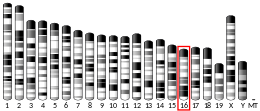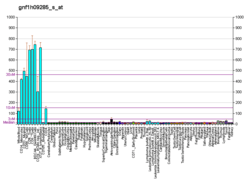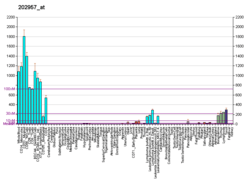HCLS1
Hematopoietic lineage cell-specific protein is a protein that in humans is encoded by the HCLS1 gene.[5][6][7]
Interactions
HCLS1 has been shown to interact with Caspase 3.[8][9]
gollark: Not in one project, in multiple projects.
gollark: And you don't have some convenient standard "required library manifest" per project.
gollark: And you can't have multiple versions per project.
gollark: Well, it means every distro has to deal with packaging every library someone might want.
gollark: Also, header files bad.
References
- GRCh38: Ensembl release 89: ENSG00000180353 - Ensembl, May 2017
- GRCm38: Ensembl release 89: ENSMUSG00000022831 - Ensembl, May 2017
- "Human PubMed Reference:". National Center for Biotechnology Information, U.S. National Library of Medicine.
- "Mouse PubMed Reference:". National Center for Biotechnology Information, U.S. National Library of Medicine.
- Egashira M, Kitamura D, Watanabe T, Niikawa N (Jan 1997). "The human HCLS1 gene maps to chromosome 3q13 by fluorescence in situ hybridization". Cytogenet Cell Genet. 72 (2–3): 175–6. doi:10.1159/000134179. PMID 8978766.
- van Rossum AG, Schuuring-Scholtes E, van Buuren-van Seggelen V, Kluin PM, Schuuring E (Mar 2005). "Comparative genome analysis of cortactin and HS1: the significance of the F-actin binding repeat domain". BMC Genomics. 6: 15. doi:10.1186/1471-2164-6-15. PMC 554100. PMID 15710041.
- "Entrez Gene: HCLS1 hematopoietic cell-specific Lyn substrate 1".
- Ruzzene, Maria; Penzo Daniele; Pinna Lorenzo A (May 2002). "Protein kinase CK2 inhibitor 4,5,6,7-tetrabromobenzotriazole (TBB) induces apoptosis and caspase-dependent degradation of haematopoietic lineage cell-specific protein 1 (HS1) in Jurkat cells". Biochem. J. England. 364 (Pt 1): 41–7. doi:10.1042/bj3640041. ISSN 0264-6021. PMC 1222543. PMID 11988074.
- Chen, Y R; Kori R; John B; Tan T H (Nov 2001). "Caspase-mediated cleavage of actin-binding and SH3-domain-containing proteins cortactin, HS1, and HIP-55 during apoptosis". Biochem. Biophys. Res. Commun. United States. 288 (4): 981–9. doi:10.1006/bbrc.2001.5862. ISSN 0006-291X. PMID 11689006.
Further reading
- Kitamura D, Kaneko H, Miyagoe Y, et al. (1990). "Isolation and characterization of a novel human gene expressed specifically in the cells of hematopoietic lineage". Nucleic Acids Res. 17 (22): 9367–79. PMC 335138. PMID 2587259.
- Yamanashi Y, Okada M, Semba T, et al. (1993). "Identification of HS1 protein as a major substrate of protein-tyrosine kinase(s) upon B-cell antigen receptor-mediated signaling". Proc. Natl. Acad. Sci. U.S.A. 90 (8): 3631–5. Bibcode:1993PNAS...90.3631Y. doi:10.1073/pnas.90.8.3631. PMC 46355. PMID 7682714.
- Hata D, Nakamura T, Kawakami T, et al. (1994). "Tyrosine phosphorylation of MB-1, B29, and HS1 proteins in human B cells following receptor crosslinking". Immunol. Lett. 40 (1): 65–71. doi:10.1016/0165-2478(94)90208-9. PMID 7927516.
- Maruyama K, Sugano S (1994). "Oligo-capping: a simple method to replace the cap structure of eukaryotic mRNAs with oligoribonucleotides". Gene. 138 (1–2): 171–4. doi:10.1016/0378-1119(94)90802-8. PMID 8125298.
- Egerton M, Moritz RL, Druker B, et al. (1996). "Identification of the 70kD heat shock cognate protein (Hsc70) and alpha-actinin-1 as novel phosphotyrosine-containing proteins in T lymphocytes". Biochem. Biophys. Res. Commun. 224 (3): 666–74. doi:10.1006/bbrc.1996.1082. PMID 8713105.
- Suzuki Y, Demoliere C, Kitamura D, et al. (1997). "HAX-1, a novel intracellular protein, localized on mitochondria, directly associates with HS1, a substrate of Src family tyrosine kinases". J. Immunol. 158 (6): 2736–44. PMID 9058808.
- Yamanashi Y, Fukuda T, Nishizumi H, et al. (1997). "Role of tyrosine phosphorylation of HS1 in B cell antigen receptor-mediated apoptosis". J. Exp. Med. 185 (7): 1387–92. doi:10.1084/jem.185.7.1387. PMC 2196252. PMID 9104825.
- Suzuki Y, Yoshitomo-Nakagawa K, Maruyama K, et al. (1997). "Construction and characterization of a full length-enriched and a 5'-end-enriched cDNA library". Gene. 200 (1–2): 149–56. doi:10.1016/S0378-1119(97)00411-3. PMID 9373149.
- Brunati AM, Donella-Deana A, James P, et al. (1999). "Molecular features underlying the sequential phosphorylation of HS1 protein and its association with c-Fgr protein-tyrosine kinase". J. Biol. Chem. 274 (11): 7557–64. doi:10.1074/jbc.274.11.7557. PMID 10066823.
- Nagata Y, Kiefer F, Watanabe T, Todokoro K (1999). "Activation of hematopoietic progenitor kinase-1 by erythropoietin". Blood. 93 (10): 3347–54. PMID 10233887.
- Takemoto Y, Furuta M, Sato M, et al. (2000). "Isolation and characterization of a novel HS1 SH3 domain binding protein, HS1BP3". Int. Immunol. 11 (12): 1957–64. doi:10.1093/intimm/11.12.1957. PMID 10590261.
- Ruzzene M, Brunati AM, Sarno S, et al. (2000). "Ser/Thr phosphorylation of hematopoietic specific protein 1 (HS1): implication of protein kinase CK2". Eur. J. Biochem. 267 (10): 3065–72. doi:10.1046/j.1432-1033.2000.01333.x. PMID 10806407.
- Chen YR, Kori R, John B, Tan TH (2001). "Caspase-mediated cleavage of actin-binding and SH3-domain-containing proteins cortactin, HS1, and HIP-55 during apoptosis". Biochem. Biophys. Res. Commun. 288 (4): 981–9. doi:10.1006/bbrc.2001.5862. PMID 11689006.
- Ruzzene M, Penzo D, Pinna LA (2002). "Protein kinase CK2 inhibitor 4,5,6,7-tetrabromobenzotriazole (TBB) induces apoptosis and caspase-dependent degradation of haematopoietic lineage cell-specific protein 1 (HS1) in Jurkat cells". Biochem. J. 364 (Pt 1): 41–7. doi:10.1042/bj3640041. PMC 1222543. PMID 11988074.
- Strausberg RL, Feingold EA, Grouse LH, et al. (2003). "Generation and initial analysis of more than 15,000 full-length human and mouse cDNA sequences". Proc. Natl. Acad. Sci. U.S.A. 99 (26): 16899–903. Bibcode:2002PNAS...9916899M. doi:10.1073/pnas.242603899. PMC 139241. PMID 12477932.
- Salomon AR, Ficarro SB, Brill LM, et al. (2003). "Profiling of tyrosine phosphorylation pathways in human cells using mass spectrometry". Proc. Natl. Acad. Sci. U.S.A. 100 (2): 443–8. Bibcode:2003PNAS..100..443S. doi:10.1073/pnas.2436191100. PMC 141014. PMID 12522270.
- Uruno T, Zhang P, Liu J, et al. (2003). "Haematopoietic lineage cell-specific protein 1 (HS1) promotes actin-related protein (Arp) 2/3 complex-mediated actin polymerization". Biochem. J. 371 (Pt 2): 485–93. doi:10.1042/BJ20021791. PMC 1223309. PMID 12534372.
- Ota T, Suzuki Y, Nishikawa T, et al. (2004). "Complete sequencing and characterization of 21,243 full-length human cDNAs". Nat. Genet. 36 (1): 40–5. doi:10.1038/ng1285. PMID 14702039.
- Brill LM, Salomon AR, Ficarro SB, et al. (2004). "Robust phosphoproteomic profiling of tyrosine phosphorylation sites from human T cells using immobilized metal affinity chromatography and tandem mass spectrometry". Anal. Chem. 76 (10): 2763–72. doi:10.1021/ac035352d. PMID 15144186.
This article is issued from Wikipedia. The text is licensed under Creative Commons - Attribution - Sharealike. Additional terms may apply for the media files.





